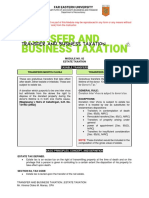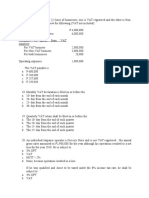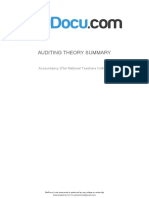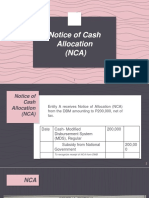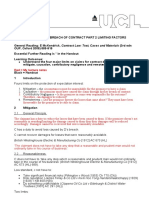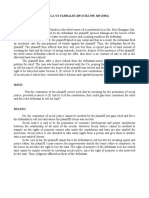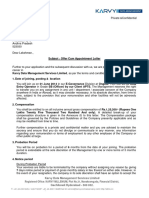1st Semester Transfer Taxation Module 1 Succession and Transfer Tax
1st Semester Transfer Taxation Module 1 Succession and Transfer Tax
Uploaded by
Nah HamzaCopyright:
Available Formats
1st Semester Transfer Taxation Module 1 Succession and Transfer Tax
1st Semester Transfer Taxation Module 1 Succession and Transfer Tax
Uploaded by
Nah HamzaCopyright
Available Formats
Share this document
Did you find this document useful?
Is this content inappropriate?
Copyright:
Available Formats
1st Semester Transfer Taxation Module 1 Succession and Transfer Tax
1st Semester Transfer Taxation Module 1 Succession and Transfer Tax
Uploaded by
Nah HamzaCopyright:
Available Formats
FAR EASTERN UNIVERSITY
INSTITUTE OF ACCOUNTS BUSINESS AND FINANCE
Department of Accountancy
DISCLAIMER: Kindly note that no part of this Module may be reproduced in any form or any means without
the permission (e.g., written or oral) from the Instructor.
MODULE NO. 01
SUCCESSION AND TRANSFER TAX
MODES OF ACQUIRING OWNERSHIP (COLD TIPS ) Article 712, Civil Code:
The effectiveness of the various modes of acquiring ownership and other real rights over property is
premised on the existence of title or judicial justifications. The following are the different modes of acquiring
ownership:
✓ Contract
✓ Occupation - property seized is without a known owner
✓ Intellectual creation
✓ Law
✓ Prescription
o Acquisitive Prescription - one acquires ownership and other real rights through the lapse
of time in the manner and under the conditions laid down by law
o Extinctive Prescription – one rights, and actions are lost by prescription
✓ Tradition
✓ Succession - mode of acquisition by virtue of which the property, rights and obligations to the extent
of the value of the inheritance, of a person are transmitted through his death to another
✓ Donation - an act of liberty whereby a person disposes gratuitously of a thing or right in favor of
another, who accepts it
BUSINESS AND TRANSFER TAXATION MIND MAP
TRANSACTION
BILATERAL TRANSFER COMPLEX TANSFER UNILATERAL TRANSFER
This involves the transmission Complex transfers are Unilateral transfers involve the
of property for a consideration. transfers for less than full and transmission of property by a
They are referred to as adequate consideration. These person without consideration.
onerous transactions or are sales made at prices which They are commonly referred to
exchanges. are significantly lower than the as, gratuitous transactions
fair value of the property sold. or simply, transfers.
Examples Transfer Tax Examples
Sale Fair Market Value Donation
Barter Less: Consideration Received Succession
Subject to Transfer Tax
Business Tax Consideration Received Transfer Tax
Value-Added Tax Less: Cost of Property Donor’s Tax
Other Percentage Taxes Subject to Business Tax Estate Tax
TRANSFER AND BUSINESS TAXATION | Succession and Transfer Tax
Mr. Kireina Otoko M. Manas, CPA
FAR EASTERN UNIVERSITY
INSTITUTE OF ACCOUNTS BUSINESS AND FINANCE
Department of Accountancy
TRANSFER TAXATION MIND MAP
TRANSFER TAX
Transfer Tax is an ‘Excise Tax’.
• The subject matter of Transfer Tax is the privilege of the transferor to gratuitously transfer
property or rights which takes effect at the date of the transferor or during the lifetime of the
donor and donee.
Donation Inter Vivos Donation Mortis Causa
• Gratuitous transfer that take effect during • Gratuitous transfer that take effect at the
the lifetime of both the donor and donee. time of the death of the donor.
• Donation is the willful act of the donor to
transfer his rights/properties to the donee
for free.
• Donation to be valid needs to satisfy the
four essential elements;
• Capacity of the Donor;
• Donative Intent;
• Delivery of the Gift; and
• Acceptance of the Donee.
Donor’s Tax Estate Tax
SUCCESSION DEFINED
Article 774, Civil Code
✓ Succession is a mode of acquisition by virtue of which, the property, rights, and obligations to the
extent of the value of inheritance, of a person are transmitted through his death to another or others
either by his will or by operation of law.
Article 776, Civil Code
✓ The inheritance includes all the property, rights, and obligations of a person which are not
extinguished by his death.
Article 777, Civil Code
✓ The rights to the succession are transmitted from the moment of death of the decedent.
NOTE: This is notwithstanding the postponement of the actual possession or enjoyment of the
estate by the beneficiary (Section 3, RR 2-2003).
KINDS OF SUCCESSION (ARTICLE 778, CIVIL CODE)
Testamentary or Testate Succession
✓ A type of succession that results from the designation of an heir, made in a will executed in the
form prescribed by law.
Legal or Intestate Succession
✓ A type of succession which is effected by operations of law since the decedent did not execute a
will or if the last will and testament executed by him is void.
Mixed Succession
CAUSES OF LEGAL SUCCESSION OR INTESTACY
1. If a person dies without a will, or with a void will, or one which has subsequently lost its validity;
2. When the will does not institute an heir;
3. Partial institution of heir. Consequently, intestacy takes place as to the undisposed portion;
4. When the heir instituted is incapable of succeeding; and
5. Other causes such as:
TRANSFER AND BUSINESS TAXATION | Succession and Transfer Tax
Mr. Kireina Otoko M. Manas, CPA
FAR EASTERN UNIVERSITY
INSTITUTE OF ACCOUNTS BUSINESS AND FINANCE
Department of Accountancy
o Non-fulfillment of the suspensive condition attached to the institution of heir. Suspensive
condition is a condition depending upon the happening of an uncertain event which must
be fulfilled before an obligation arises;
o Preterition (omission in the testator’s will of one, some or all of the compulsory heirs in
the direct line which has the effect of annulling the institution of heir);
o Fulfillment of “resolutory condition.” A resolutory condition refers to a condition whereby,
upon fulfillment terminates an already enforceable obligation;
o Expiration of term or period of institution;
o Non-compliance or impossibility of compliance with the will; and
o Repudiation of instituted heir.
ELEMENTS OF SUCCESSION
✓ Decedent is the person whose property is transmitted through succession, whether of not he left
a will. If he left a will, he is called Testator (Article 775, Civil Code).
✓ Executor is the person designated in the last will and testament to carry out the provisions of the
decedent’s will. He also performs the fiduciary duty (i.e., taking care of the decedent’s estate prior
to final disposition to heirs).
✓ Administrator is the person appointed by the court and performs the same duty, in lieu of the
executor, if;
o the executor refused to accept the appointment; and
o failed to qualify under the law or the last will and testament did not appoint one.
✓ Inheritance or Estate includes all the property, rights, and obligations of a person which are not
extinguished by death and all which have accrued thereto since the opening of succession.
NOTE: Rights which are purely personal and not transmissible for they are extinguished by death
(Article 776, Civil Code).
✓ Successor or Heir is a person who is called to the succession either by provision of a will or by
operation of law (Article 782, Civil Code).
o Devisees are persons to whom gifts of real property are given by virtue of a will; and
o Legatees are persons to whom gifts of personal property are given by virtue of will.
CLASSIFICATION OF SUCCESSOR OR HEIR
✓ COMPULSORY HEIRS
o Compulsory Heirs succeed by force of law to some portion of the inheritance, in an amount
predetermined by law, known as legitime.
o Compulsory Heirs cannot be deprived by the testator of their legitime except by
disinheritance properly effected.
o Kinds of Compulsory Heirs;
▪ Primary have precedence over and exclude other compulsory heirs;
Example/s: Legitimate children and their legitimate descendants
▪ Secondary succeeds only in the absence of the primary compulsory heirs; and
Example/s: Legitimate parents and ascendants
▪ Concurring succeed together with the primary of secondary compulsory heirs.
Example/s: Illegitimate children and their descendants whether legitimate or
illegitimate, and Surviving spouse
NOTE: Illegitimate parents may inherit only in default of legitimate children and
their legitimate descendants, and illegitimate children and their
descendants whether legitimate or illegitimate
✓ VOLUNTARY HEIRS
o Voluntary Heirs are those instituted by the testator in his last will to succeed to the
inheritance of the portion thereof of which the testator can freely dispose.
o Free portion refers to the portion or value left in the estate after deducting the legitime of
the compulsory heirs.
NOTE: The share of voluntary heirs is determined through the last will and testament.
✓ LEGAL OR INTESTATE HEIRS
o Legal or Intestate Heirs are those who succeeds to the estate of the decedent by operation
of law.
TRANSFER AND BUSINESS TAXATION | Succession and Transfer Tax
Mr. Kireina Otoko M. Manas, CPA
FAR EASTERN UNIVERSITY
INSTITUTE OF ACCOUNTS BUSINESS AND FINANCE
Department of Accountancy
ORDER OF INTESTATE SUCCESSION
LEGITIME
✓ It is part of a testator’s property which he cannot dispose of because the law has reserved it for
certain heirs who are, therefore, called compulsory heirs (Article 886, Civil Code).
NOTE: The compulsory heirs cannot be deprived of their legitime by the testators except by
disinheritance properly effected.
FREE PORTION
✓ It is that portion of the estate which the testator can freely dispose of, and anyone may inherit from
this portion (e.g., compulsory heirs and voluntary heirs).
NOTE: Voluntary heirs may inherit only if mentioned in the will. In the absence of a provision in a
will, voluntary heirs will not inherit anything.
✓ In such cases, the free portion shall be disposed of to intestate heirs based in the order of priority:
1. Legitimate Children or Descendants;
2. Legitimate Parents or Ascendants;
3. Illegitimate Children or Descendants;
4. Surviving Spouse;
5. Brother and Sisters, Nephews, and Nieces;
6. Other Collateral Relatives within the 5th Degree; and
7. State or the Government.
COLLATERAL RELATIVES
CONSANGUINITY
✓ It is the relation of persons descending from the same stock or common ancestors. These persons
are known as blood relatives, and are said to be related by blood or consanguinity. It may be lineal
or collateral.
✓ TYPES OF CONSANGUINITY.
o Lineal Consanguinity
▪ Lineal Consanguinity, which may be descending or ascending, is that which
subsists between persons of whom one is descended in a direct line from the other.
o Collateral Consanguinity
▪ Collateral Consanguinity is that which subsists between persons who have the
same ancestors, but who not descend or ascend one from the other.
TRANSFER AND BUSINESS TAXATION | Succession and Transfer Tax
Mr. Kireina Otoko M. Manas, CPA
FAR EASTERN UNIVERSITY
INSTITUTE OF ACCOUNTS BUSINESS AND FINANCE
Department of Accountancy
WILL
✓ A will is an act whereby a person is permitted, with the formalities prescribed by law, to control to
a certain degree the disposition of his estate to take effect after his death (Article 783, Civil Code).
✓ It is a document whereby a person, called the testator, disposes of his or her properties or estate
to take effect upon his or her death.
✓ The making of will is a strictly personal act. Hence, it cannot be left in the whole or in part of the
discretion of a third person or accomplished through the instrumentality of an agent or attorney.
NOTE: The persons prohibited by law to make a will are those below 18 years old and those who
are not of sound mind at the time of its execution.
KINDS OF WILL
1. NOTARIAL, ORDINARY, OR ATTESTED WILL
o This is one which is executed in accordance with the formalities prescribed by Article 804
to Article 808 of the Civil Code.
o REQUISITES FOR A VALID NOTARIAL WILL
▪ It must be in writing and executed in a language or dialect known to the testator;
▪ It must be subscribed at the end thereof by the testator himself or by testator’s
name written by some other person in his presence and by his express direction;
and
▪ It must be attested and subscribed by three or more credible witnesses in the
presence of the testator and of one another.
▪ DISQUALIFIED WITNESSES (ARTICLE 821, CIVIL CODE)
• Any person not domiciled in the Philippines; and
• Any person who have been convicted of falsification of a
document, perjury, or false testimony.
2. HOLOGRAPHIC WILL
o It is a written will which must be entirely written, dated, and signed by the hand of the
testators himself.
o It subject to no other form and it may be made in or out of the Philippines and need not be
witnessed (Article 811, Civil Code).
NOTE: In case of any inspection, cancellation, erasure or alteration in a holographic will,
the testator must authenticate the same by his full signature.
o CODOCIL is a supplement or addition to a will, made after the execution of a will and
annexed to be taken as a part thereof, by which any disposition made in the original will is
explained, added to or altered.
NOTE: In order that a codicil may be effective, it shall be executed as in the case of a will
(Article 825 and Article 826, Civil Code).
MODES OF REVOKING A WILL
A will may be revoked by the testator at any time before his death any waiver or restriction of this right is
void (Article 828, Civil Code). The following are the modes of revoking a will;
✓ By implication of law;
✓ By some will, codicil, or other writing executed as provided in case of will; and
✓ By burning, tearing, cancelling, or obliterating the will with the intention of revoking it, by the testator
himself, or by some other person in his presence, and by his express direction.
-END OF MODULE 1-
TRANSFER AND BUSINESS TAXATION | Succession and Transfer Tax
Mr. Kireina Otoko M. Manas, CPA
You might also like
- The Place of Equity and Equitable Remedies in The Contemporary Common Law WorldDocument15 pagesThe Place of Equity and Equitable Remedies in The Contemporary Common Law Worldme elk100% (3)
- Accounting Gov ReviewerDocument19 pagesAccounting Gov ReviewerAira Jaimee Gonzales100% (1)
- Ampongan Chap 1Document2 pagesAmpongan Chap 1iamjan_101No ratings yet
- Pinnacle CPA Review App Packages PDFDocument7 pagesPinnacle CPA Review App Packages PDFMark DaryllNo ratings yet
- TaxationDocument9 pagesTaxationGio PacayraNo ratings yet
- Answer Key Prelim Exam PDFDocument10 pagesAnswer Key Prelim Exam PDFShane Torrie100% (1)
- 1st Semester Transfer Taxation Module 2 Estate TaxationDocument16 pages1st Semester Transfer Taxation Module 2 Estate TaxationNah Hamza100% (1)
- Intermediate Accounting 2 and 3 FinalDocument67 pagesIntermediate Accounting 2 and 3 FinalNah HamzaNo ratings yet
- 3 Floor, Business & Engineering Building, Matina, Davao City Telefax: (082) 300-1496 Phone No.: (082) 244-34-00 Local 137Document13 pages3 Floor, Business & Engineering Building, Matina, Davao City Telefax: (082) 300-1496 Phone No.: (082) 244-34-00 Local 137Abigail Ann PasiliaoNo ratings yet
- Module For TAX2 April 3 2020 THIRD QTR EXAMSDocument7 pagesModule For TAX2 April 3 2020 THIRD QTR EXAMSFranz Ana Marie CuaNo ratings yet
- Estate Tax 3Document50 pagesEstate Tax 3Lea JoaquinNo ratings yet
- SCRC 3 CorporationDocument18 pagesSCRC 3 CorporationChristine Yedda Marie AlbaNo ratings yet
- Departmental Finals Answer Key PDFDocument4 pagesDepartmental Finals Answer Key PDFJacob AcostaNo ratings yet
- Afar 2019Document9 pagesAfar 2019TakuriNo ratings yet
- Chapter 14Document21 pagesChapter 14Kim Patrice NavarraNo ratings yet
- Lecture 2c - Dealings in PropertyDocument4 pagesLecture 2c - Dealings in PropertyCPANo ratings yet
- 18 Special Purpose Audit EngagementDocument2 pages18 Special Purpose Audit EngagementIrish SanchezNo ratings yet
- Ale Aubrey Bsma 3 1.lguDocument6 pagesAle Aubrey Bsma 3 1.lguAstrid XiNo ratings yet
- Government Accounting REVIEWERDocument2 pagesGovernment Accounting REVIEWERMichelle Galapon LagunaNo ratings yet
- Consumer Protection Act NotesDocument6 pagesConsumer Protection Act NotesAbarilles, Sherinah Mae P.No ratings yet
- Week 7 Module 7 TAX2 - Business and Transfer Taxation - PADAYHAGDocument23 pagesWeek 7 Module 7 TAX2 - Business and Transfer Taxation - PADAYHAGfernan opeliñaNo ratings yet
- Problem 1: The Statement of Affairs: Straight ProblemsDocument5 pagesProblem 1: The Statement of Affairs: Straight ProblemsJemNo ratings yet
- Lyceum of The Philippines University Manila College of Business AdministrationDocument166 pagesLyceum of The Philippines University Manila College of Business AdministrationVanessa SisonNo ratings yet
- Advance Financial Accounting and Reporting: Franchise IAS 18Document4 pagesAdvance Financial Accounting and Reporting: Franchise IAS 18Roxell CaibogNo ratings yet
- Donors Tax DWCLDocument6 pagesDonors Tax DWCLKyle Jezrel GimaoNo ratings yet
- Estate Tax Activities (Questions)Document4 pagesEstate Tax Activities (Questions)Christine Nathalie BalmesNo ratings yet
- TOA CparDocument12 pagesTOA CparHerald Gangcuangco100% (2)
- At PDF FreeDocument15 pagesAt PDF FreemaekaellaNo ratings yet
- Ae 313 - Prelim Exam: TheoryDocument7 pagesAe 313 - Prelim Exam: TheoryNicole ViernesNo ratings yet
- Syllabi HRMA 40023 Project Management 2Document6 pagesSyllabi HRMA 40023 Project Management 2BSMA Third YearNo ratings yet
- Review MaterialsDocument17 pagesReview MaterialsElizah Faye AlcantaraNo ratings yet
- HEHEDocument22 pagesHEHEKenNo ratings yet
- Accounting Methods And: Installment Reporting of IncomeDocument15 pagesAccounting Methods And: Installment Reporting of IncomeRoronoa ZoroNo ratings yet
- Documentary Stamp TaxDocument13 pagesDocumentary Stamp TaxJessNo ratings yet
- AGAP Scholarship ProgramDocument3 pagesAGAP Scholarship ProgramDaneen GastarNo ratings yet
- HOMEWORK 1 Concept of TaxationDocument5 pagesHOMEWORK 1 Concept of Taxationfitz garlitosNo ratings yet
- Chapter 1 and DIYDocument8 pagesChapter 1 and DIYJymldy EnclnNo ratings yet
- Gross Income: Valencia CH 6 Answer KeyDocument46 pagesGross Income: Valencia CH 6 Answer KeyShane TorrieNo ratings yet
- Integrative Course For Taxation Ateneo de Zamboanga University Accountancy Department Estate TaxDocument3 pagesIntegrative Course For Taxation Ateneo de Zamboanga University Accountancy Department Estate TaxElizabeth ApolonioNo ratings yet
- Iueeu CoaDocument4 pagesIueeu Coayes it's kaiNo ratings yet
- Chapter 11 AISDocument4 pagesChapter 11 AISMyka ManalotoNo ratings yet
- Business Combination - I: "Your Online Partner To Get Your Title"Document8 pagesBusiness Combination - I: "Your Online Partner To Get Your Title"Arlene Diane OrozcoNo ratings yet
- National Federation of Junior Philipinne Institute of Accountants - National Capital Region Taxation (Tax)Document10 pagesNational Federation of Junior Philipinne Institute of Accountants - National Capital Region Taxation (Tax)joyceNo ratings yet
- Module 3 - Donors Tax PDFDocument5 pagesModule 3 - Donors Tax PDFIo AyaNo ratings yet
- Center For Review and Special Studies - : Practical Accounting 1/theory of Accounts M. B. GuiaDocument13 pagesCenter For Review and Special Studies - : Practical Accounting 1/theory of Accounts M. B. GuiaWilsonNo ratings yet
- Quiz Shareholders Equity TH With Questions PDFDocument4 pagesQuiz Shareholders Equity TH With Questions PDFMichael Angelo FangonNo ratings yet
- Gross Estate: Common Shares - Book Value Preference Shares - Par ValueDocument3 pagesGross Estate: Common Shares - Book Value Preference Shares - Par ValueMichael AquinoNo ratings yet
- Final ExamDocument10 pagesFinal ExamAllen Fey De JesusNo ratings yet
- Applied Auditing: 3/F F. Facundo Hall, B & E Bldg. Matina, Davao City Philippines Phone No.: (082) 305-0645Document7 pagesApplied Auditing: 3/F F. Facundo Hall, B & E Bldg. Matina, Davao City Philippines Phone No.: (082) 305-0645Bryan PiañarNo ratings yet
- Insurance Contracts and Service ConcessionDocument2 pagesInsurance Contracts and Service Concessionss calogsNo ratings yet
- Vat 2Document4 pagesVat 2Allen KateNo ratings yet
- Auditing Theory Summary Auditing Theory SummaryDocument42 pagesAuditing Theory Summary Auditing Theory SummaryCJ TinNo ratings yet
- Chap 004Document149 pagesChap 004Jessica Cola100% (2)
- Business CombinationDocument7 pagesBusiness CombinationEmma Mariz GarciaNo ratings yet
- RFBT (Pinnacle Notes)Document1 pageRFBT (Pinnacle Notes)Justz LimNo ratings yet
- Corporate Income TaxDocument6 pagesCorporate Income TaxMark Domingo MendozaNo ratings yet
- Final Preboard TaxDocument8 pagesFinal Preboard TaxYaj Cruzada100% (1)
- Transfer TaxesDocument69 pagesTransfer TaxesPETERWILLE CHUANo ratings yet
- Name: Napoleon C. Lomotan Professor: Dean Cordova Year and Section: BSA-4A Date: January 23, 2019Document6 pagesName: Napoleon C. Lomotan Professor: Dean Cordova Year and Section: BSA-4A Date: January 23, 2019JenniferFajutnaoArcosNo ratings yet
- Folleto para El Consumidor - El Fideicomiso Revocable en Florida - Colegio de Abogados de FloridaDocument9 pagesFolleto para El Consumidor - El Fideicomiso Revocable en Florida - Colegio de Abogados de FloridamarcorteganoNo ratings yet
- Atlas Reviewer Transfer and Business Tax p1Document25 pagesAtlas Reviewer Transfer and Business Tax p1ABIGAIL DAYOTNo ratings yet
- Intro To Buss Transfer Tax Succession and Transfer Taxes PDFDocument15 pagesIntro To Buss Transfer Tax Succession and Transfer Taxes PDFChreazel RemigioNo ratings yet
- Estate TaxDocument141 pagesEstate TaxEldrich BulakNo ratings yet
- Week 3 - DEEDS copy 3Document84 pagesWeek 3 - DEEDS copy 3derby9969No ratings yet
- Transfer and Business TaxationDocument4 pagesTransfer and Business TaxationSintos Carlos MiguelNo ratings yet
- Notice of Cash Allocation PDFDocument17 pagesNotice of Cash Allocation PDFNah HamzaNo ratings yet
- Prelim Advac Set ADocument3 pagesPrelim Advac Set ANah HamzaNo ratings yet
- Assignment Budget and Accounting Entries Questions PDFDocument4 pagesAssignment Budget and Accounting Entries Questions PDFNah HamzaNo ratings yet
- Source of Funds Appropriations Allotments Obligations Current Budget 1. Agency Specific BudgetDocument7 pagesSource of Funds Appropriations Allotments Obligations Current Budget 1. Agency Specific BudgetNah HamzaNo ratings yet
- 1st Semester Transfer Taxation Module 2 Estate Taxation - Summary of Concept MapsDocument5 pages1st Semester Transfer Taxation Module 2 Estate Taxation - Summary of Concept MapsNah HamzaNo ratings yet
- 1st Semester Transfer Taxation Module 3 Estate Taxation - DeductionsDocument13 pages1st Semester Transfer Taxation Module 3 Estate Taxation - DeductionsNah HamzaNo ratings yet
- Cfas Exercises 6 9 Hehehe PDFDocument45 pagesCfas Exercises 6 9 Hehehe PDFNah HamzaNo ratings yet
- This Study Resource Was: Intermediate Accounting 3 (Interim)Document2 pagesThis Study Resource Was: Intermediate Accounting 3 (Interim)Nah HamzaNo ratings yet
- This Study Resource Was: Fellowship Baptist College College of Business and AccountancyDocument5 pagesThis Study Resource Was: Fellowship Baptist College College of Business and AccountancyNah HamzaNo ratings yet
- WDocument1 pageWNah HamzaNo ratings yet
- Prelim ExamDocument13 pagesPrelim ExamNah HamzaNo ratings yet
- CIV2-Mahinay Vs Dura TireDocument18 pagesCIV2-Mahinay Vs Dura TireMark John Geronimo BautistaNo ratings yet
- Cornerstone LPA VC LabDocument33 pagesCornerstone LPA VC LabColina QuyenColin TranNo ratings yet
- Form 3Document5 pagesForm 3nemij36339No ratings yet
- Lecture2022 Lecture13 - On Remedies - DamagesDocument16 pagesLecture2022 Lecture13 - On Remedies - DamagesJacksonVanHerdenAlmeidaNo ratings yet
- 2013-2014 CAST Membership ApplicationDocument1 page2013-2014 CAST Membership Applicationc2003990No ratings yet
- Couture OpinionDocument11 pagesCouture Opinionandybaker260No ratings yet
- Remedies Lecture 2 - Limiting FactorsDocument4 pagesRemedies Lecture 2 - Limiting FactorsAdam 'Fez' FerrisNo ratings yet
- Holly Plaza Lawsuit UpdateDocument14 pagesHolly Plaza Lawsuit UpdateJane BouletNo ratings yet
- Jaswant Singh Gill Vs Bharat Coking Coal LTD and Os060929COM103287Document7 pagesJaswant Singh Gill Vs Bharat Coking Coal LTD and Os060929COM103287Ruchir JoshiNo ratings yet
- Week1 COMPARATIVE CASESDocument53 pagesWeek1 COMPARATIVE CASESGersonGamasNo ratings yet
- Land Aquisition For Development RegularDocument171 pagesLand Aquisition For Development RegularabinetbantiNo ratings yet
- GST on goodwill at the time of retirement of PartnersDocument6 pagesGST on goodwill at the time of retirement of PartnersNagadheep SathyanarayanaNo ratings yet
- Harmonious Coretrades V United Integrated Services (2019) SGCA 77 (Amended 191212)Document15 pagesHarmonious Coretrades V United Integrated Services (2019) SGCA 77 (Amended 191212)Frank860610No ratings yet
- Application For Registration On The Indian Register and For The Secure Certificate of Indian Status (Scis)Document6 pagesApplication For Registration On The Indian Register and For The Secure Certificate of Indian Status (Scis)alpha taurusNo ratings yet
- Leave FormDocument3 pagesLeave FormElona Jane CapangpanganNo ratings yet
- Abalos, Brigid - Compiled Corporation Law Case Digests-55 CASESDocument73 pagesAbalos, Brigid - Compiled Corporation Law Case Digests-55 CASESMARFENo ratings yet
- MarriottDocument18 pagesMarriottStephen LemonsNo ratings yet
- Salonga Vs Farrales Digest Ful Case PDF FreeDocument6 pagesSalonga Vs Farrales Digest Ful Case PDF FreeElyka RamosNo ratings yet
- Patricia Ciobanu - wg11 - Research Seminar - Assignment2.Document7 pagesPatricia Ciobanu - wg11 - Research Seminar - Assignment2.CiobanuPatriciaNo ratings yet
- Enforcement of Partnership Rights - Who Sues For The PartnershipDocument38 pagesEnforcement of Partnership Rights - Who Sues For The PartnershipfarijamelaNo ratings yet
- Securities LawDocument13 pagesSecurities LawencinajarianjayNo ratings yet
- Chapter 4 - Legal Liability - AuditingDocument27 pagesChapter 4 - Legal Liability - AuditingKolins ChakmaNo ratings yet
- PME Write-Shop Seminar PresentationDocument19 pagesPME Write-Shop Seminar PresentationRhowelle TibayNo ratings yet
- KARVYDocument10 pagesKARVYLakshman ElchuriNo ratings yet
- EBP MBE Kramer RealPropDocument74 pagesEBP MBE Kramer RealPropkirarogers1100% (1)
- EjectmentDocument7 pagesEjectmentshreya singhNo ratings yet
- Mendez Nuñez TEMPLATE SB RESOLUTION APPROVING THE BARANGAY DTPDocument3 pagesMendez Nuñez TEMPLATE SB RESOLUTION APPROVING THE BARANGAY DTPMaia NalibsanNo ratings yet
- National Thermal Power Corporation LTD Vs Siemens S070234COM868987Document11 pagesNational Thermal Power Corporation LTD Vs Siemens S070234COM868987vikramshantu86047No ratings yet
- Concept of OmbudsmanDocument3 pagesConcept of OmbudsmanchiragNo ratings yet






